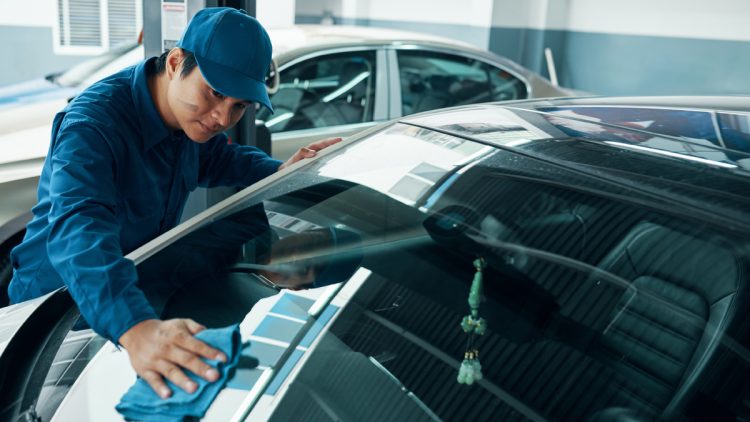Can Water Stain Car Windows?
Water alone does not typically stain car windows, as it is a relatively inert and pure substance. However, water can leave mineral deposits or water spots on car windows under certain conditions, which may create the appearance of stains. These water spots are usually caused by the minerals or impurities present in the water and can be a result of:
- Hard Water: Hard water contains dissolved minerals, primarily calcium and magnesium. When hard water dries on car windows, it can leave behind these minerals in the form of spots. These spots can be particularly noticeable if you live in an area with hard water or if you frequently wash your car with tap water.
- Mineral Buildup: Over time, the accumulation of minerals from repeated exposure to hard water can create stubborn water spots on car windows. These spots can be difficult to remove if not addressed promptly.
- Rain or Irrigation Water: Rainwater and irrigation water can also contain minerals, and when these waters evaporate on your car’s windows, they can leave behind mineral deposits or water spots.
To prevent and remove water spots from car windows, consider the following tips:
- Use Distilled Water: When washing your car or cleaning the windows, use distilled water, which is free from minerals and less likely to leave spots.
- Regular Cleaning: Clean your car’s windows regularly to remove any water spots before they become difficult to remove.
- Use a Water Spot Remover: Commercial water spot removers are available and can help dissolve and remove mineral deposits. Follow the product’s instructions for best results.
- Vinegar Solution: A solution of white vinegar and water can be effective in removing water spots. Mix equal parts of vinegar and water, apply it to the affected areas, let it sit for a few minutes, and then wipe it clean.
- Rubbing Alcohol: Rubbing alcohol can also be used to remove water spots. Apply it to a cloth or sponge and gently rub the affected areas.
- Rinse and Dry: After washing your car or using any cleaning solutions, be sure to rinse the windows thoroughly and dry them with a clean, lint-free cloth or microfiber towel to prevent water spots from forming during the drying process.
Preventing water spots on car windows through regular cleaning and the use of purified water can help maintain the clarity and appearance of your vehicle’s glass surfaces.
Cleaning car windows effectively is crucial for safe driving and visibility. Here’s a step-by-step guide on the best way to clean car windows:
Materials You’ll Need:
- Glass cleaner (commercial or homemade)
- Microfiber or lint-free cleaning cloths
- A bucket of clean water
- Soft-bristle brush (optional)
- Old newspaper (optional)
- Plastic scraper (for stubborn residue, optional)
Steps:
- Choose the Right Time: Avoid cleaning your car windows in direct sunlight or on a hot day. High temperatures can cause the cleaner to evaporate quickly, leaving streaks and making it more challenging to clean effectively. Choose a shaded or cooler location if possible.
- Prepare Your Cleaning Solution:
- You can use a commercial glass cleaner or make your own by mixing equal parts water and white vinegar or water and isopropyl alcohol.
- Add the solution to a spray bottle for easy application.
- Start with Dry Dusting (Optional): If your car’s windows are particularly dirty, you can start by gently dry dusting with a soft-bristle brush to remove loose dirt and debris.
- Spray the Glass Cleaner:
- Spray the cleaning solution directly onto the window’s surface. Be generous but avoid overspraying to prevent streaking.
- If you’re concerned about overspray onto the car’s paint or trim, you can spray the cleaner onto your cloth instead.
- Wipe with a Cloth:
- Use a microfiber or lint-free cleaning cloth to wipe the glass. Work in straight, overlapping motions rather than in circles, which can create streaks.
- Use a separate cloth for the interior and exterior to prevent cross-contamination.
- Dry with a Clean, Dry Cloth (Optional): To prevent streaks, use a separate clean and dry cloth to wipe the glass again. Make sure it’s free of lint.
- Use Old Newspaper (Optional): Some people find that using crumpled old newspaper for the final wipe can help eliminate streaks and leave the glass sparkling. This is an old trick that can be quite effective.
- Check for Streaks and Residue: Inspect the windows for streaks or residue. If you notice any, reapply the cleaning solution and wipe again with a clean cloth.
- Address Stubborn Residue: For stubborn residue like tree sap or adhesive, you can use a plastic scraper with a gentle touch. Be careful not to scratch the glass. Apply a little extra cleaning solution to help loosen the residue.
- Clean the Edges and Seals: Don’t forget to clean the edges of the windows and the seals, as dirt and grime can accumulate there.
- Repeat for All Windows: Repeat the process for all the windows, including the front and rear windshields and side windows.
- Interior Windows: Clean the interior windows using the same process. Be mindful of any tinting on the windows and avoid abrasive cleaners that could damage it.
Remember that clean windows contribute to safer driving by ensuring better visibility. Regular maintenance and cleaning can also help preserve the life of your car’s glass.

